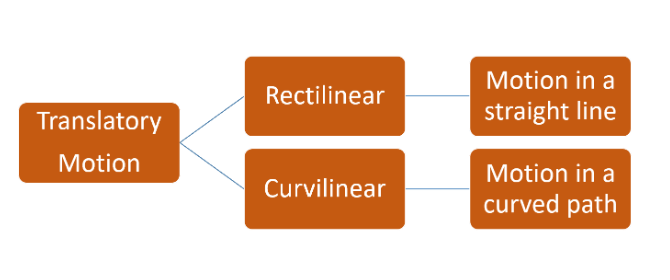
Define Translatory motion.
Answer
518.4k+ views
2 likes
- Hint: Translatory motion can be defined as a uniform motion where the different parts of the body do not change orientation with respect to each other.
Complete step-by-step solution -
Simply motion can be defined as the change of position concerning time. More broadly, motion can be defined as of three types :
Translatory motion
Rotational motion
Vibrational motion
There are many cases where the motion is described by one, two, or all of these in a single system.
Translational motion can be defined as the motion in which all points of a moving body move uniformly in the same line or direction. In due course of translation motion, the different points of an object do not change orientation to each other. Alternatively, in simple words, the body will not rotate or vibrate.
Examples: a ball moving in a parabolic path, a man walking in a straight road, etc
Translatory motion can be further classified into two types:
Curvilinear Motion
Rectilinear motion

The motion is said to be curvilinear when the body is on a curved path. It is also motion in two-three dimensions. So pure translational motion does not always have to be in a straight line. This scenario is viable if an object moves in a curved path without changing its orientation.
Whereas the motion is said to be rectilinear when the body moves in a straight path. In this scenario, all the points of the moving system move parallel to each other, which ensures that there is no change in the orientation of the points that is no rotational motion.
Few more examples of translatory motion for better understanding:
Man walking
Car or bus moving.
Boat sailing in the sea.
Cat walking.
A stone falling straight towards the surface of the earth
A coin moving over a carrom board
Note: Student maximum times confuses translator motion with the motion in a straight line, but remember this is not necessary. Translation motion can be in a curved path also.
Complete step-by-step solution -
Simply motion can be defined as the change of position concerning time. More broadly, motion can be defined as of three types :
Translatory motion
Rotational motion
Vibrational motion
There are many cases where the motion is described by one, two, or all of these in a single system.
Translational motion can be defined as the motion in which all points of a moving body move uniformly in the same line or direction. In due course of translation motion, the different points of an object do not change orientation to each other. Alternatively, in simple words, the body will not rotate or vibrate.
Examples: a ball moving in a parabolic path, a man walking in a straight road, etc
Translatory motion can be further classified into two types:
Curvilinear Motion
Rectilinear motion

The motion is said to be curvilinear when the body is on a curved path. It is also motion in two-three dimensions. So pure translational motion does not always have to be in a straight line. This scenario is viable if an object moves in a curved path without changing its orientation.
Whereas the motion is said to be rectilinear when the body moves in a straight path. In this scenario, all the points of the moving system move parallel to each other, which ensures that there is no change in the orientation of the points that is no rotational motion.
Few more examples of translatory motion for better understanding:
Man walking
Car or bus moving.
Boat sailing in the sea.
Cat walking.
A stone falling straight towards the surface of the earth
A coin moving over a carrom board
Note: Student maximum times confuses translator motion with the motion in a straight line, but remember this is not necessary. Translation motion can be in a curved path also.
Recently Updated Pages
Express the following as a fraction and simplify a class 7 maths CBSE

The length and width of a rectangle are in ratio of class 7 maths CBSE

The ratio of the income to the expenditure of a family class 7 maths CBSE

How do you write 025 million in scientific notatio class 7 maths CBSE

How do you convert 295 meters per second to kilometers class 7 maths CBSE

Write the following in Roman numerals 25819 class 7 maths CBSE

Trending doubts
State and prove Bernoullis theorem class 11 physics CBSE

What are Quantum numbers Explain the quantum number class 11 chemistry CBSE

Write the differences between monocot plants and dicot class 11 biology CBSE

Who built the Grand Trunk Road AChandragupta Maurya class 11 social science CBSE

1 ton equals to A 100 kg B 1000 kg C 10 kg D 10000 class 11 physics CBSE

State the laws of reflection of light




